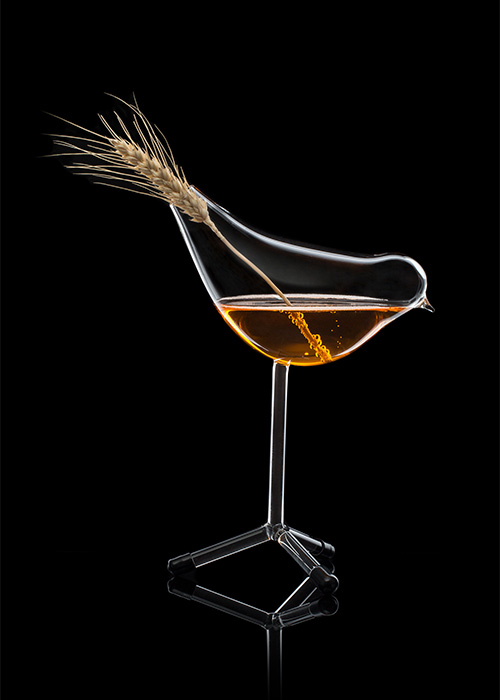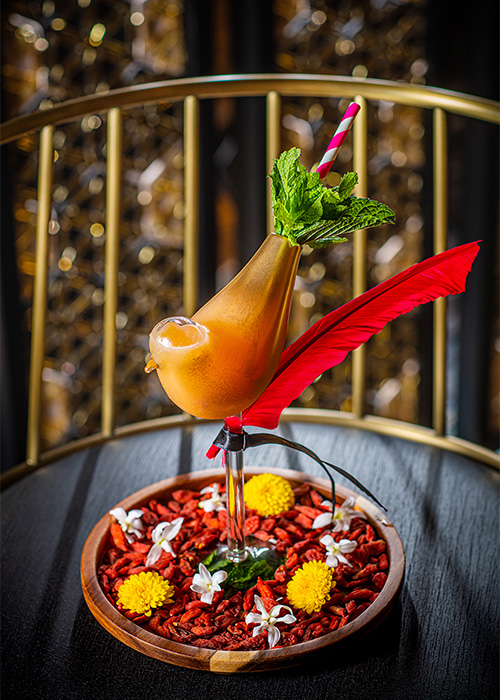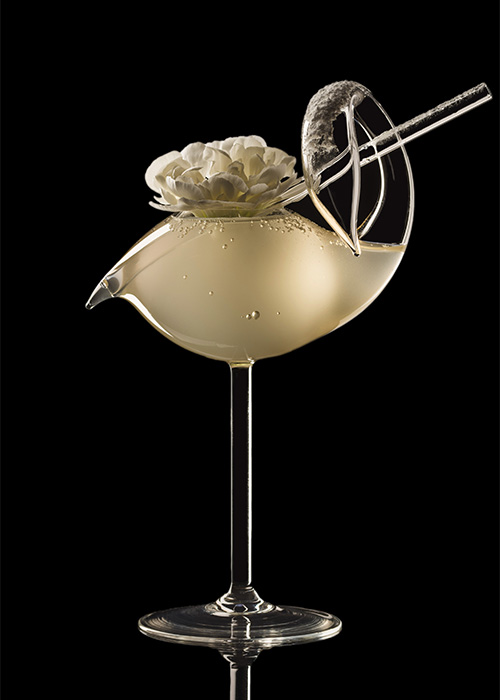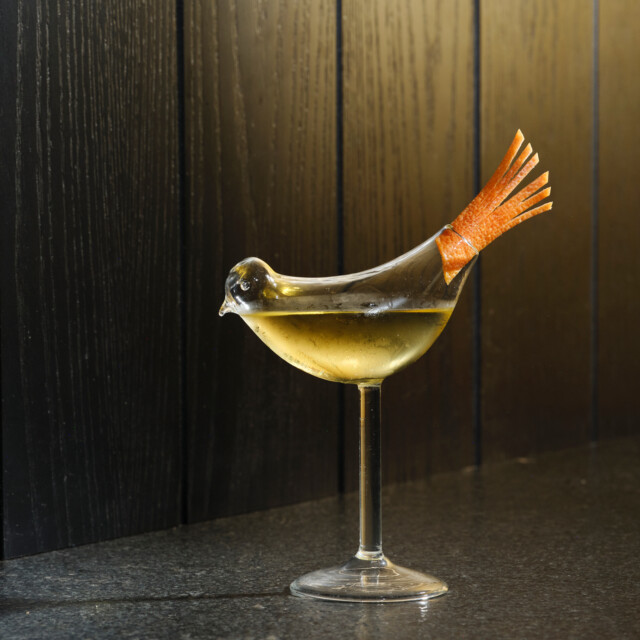“I don’t know how this started or why, but it’s here and we’d be crazy to ignore it.”
These may be the famous words of Mitch Brenner (played by Rod Taylor) in “The Birds,” Alfred Hitchcock’s 1963 horror/thriller about a small California town plagued by random, mass bird attacks. But they also apply to the strange flock of birds that has alighted on the back bar of seemingly every upmarket cocktail joint around the world.
Maybe you’ve seen one, in real life or on social media: a delicate drinking vessel formed in the elegant likeness of a sparrow or lark, with a single “leg” stem and a tubular opening for the tail, into which bartenders can stick a straw and perhaps a tweezed garnish or a little bellowful of smoke.
Drinkers have been spotted sipping from this photogenic fowl’s rear end at 2022 World’s 50 Best “Discovery” honorees, like Flisak ‘76 in Gdansk, Poland, Mesa at the Grand Lisboa Palace Resort in Macau, and Aviary in Chicago. Tokyo’s low-alcohol Low-Non-Bar pours its tart namesake cocktail into a bird-shaped glass. It’s been making the rounds on TikTok, too — the subject of lust, and near thievery, among creators at trendy outposts like The Glass Ceiling lounge and Loulou Petit Bistro. You can even drink from a bird glass at sea — perched at the Cinderella-inspired Nightingale’s Bar on the Disney Wish cruise line — perhaps while you picture it flying through your window each morning to help you dress, and instead sloshing you with gin and passion fruit juice.

Martin Jakobsen, owner and product designer at Jakobsen Design in Vsetín, Czech Republic, designed the glass at Nightingale’s, named the Lark, in 2016. “Zoomorphic inspirations,” as Jakobsen refers to them, often appear in his collections. When the Lark hit the market in 2017, it became an instant best seller — turning up at Bachleda Luxury Hotel in Krakow, posh London restaurant Clos Maggiore, and the Ritz-Carlton in Perth, Australia. In such a competitive market, “quality bars are no longer only about drinks, but also about trying to impress,” he says of the glass’s popularity.
“Everyone wants to find something that extends beyond the 14 seats at the bar, that entices and attracts guests to go and take a photo and extend the footprint of their business,” agrees Nick Bennett, beverage director of Union Square Hospitality Group’s Porchlight bar. “When you see something this genuinely different, you want to have it, like ceramic tiki mugs or brass pineapples.”
You can’t really expect something so unique to remain a secret for long in our era of oversharing. And indeed, our strange compulsion to post the things we consume as part of our public identities benefits the bars, if not often enough the makers. While Jakobsen doesn’t claim to have invented the bird vessel (bird-shaped glassware appeared as early as the tiki-crazed 1970s with the introduction of the Jungle Bird cocktail at a hotel bar in Kuala Lumpur, Malaysia), he notes that the Lark’s global success made it a target for cheap copycats. “Nowadays, there are thousands of copies on the market,” he says.
William Figueroa found one produced by Linall in 2019 after scouring the internet for animal-shaped glassware for his Los Angeles restaurant Fellow (now Wolfsglen). “I had created a drink called a Mexican Dove that was smoked,” he says. “The glass is beautiful and held smoke well.”
The glass worked so well that he also stocked a flock of them behind the bar at the Kimpton Alma hotel in San Diego, where he’s director of food and beverage. There it holds the Retrice cocktail, with High West double rye whiskey, Cointreau, grapefruit shrub, and lemon.

Unique drinking vessels also act as creative outlets for bartenders, in the same way as the liquids and ice therein. Such was the case for Nokoy Mak, master mixologist at Mesa, who debuted the glass with the whimsical Last Back Garden cocktail when Mesa opened in July 2021. (The drink, and bird, are still on the menu.)
“All of our cocktails are inspired by Macau landmarks, and this cocktail in particular is inspired by the Coloane Fishing Village, a chill and relaxing place at the southern side of Macau,” says Mak. “Sitting at the plaza, I imagined a scene of birds flying around Coloane just like a fairy tale, which I wanted to capture.”
The glass thematically supports the beverage’s “typically Asian” ingredients, including Goji berries, jasmine, and edible bird’s nest. “Its remarkable appearance and the use of this bird-shaped glass is also an important part of the message we want people to remember,” Mak says.
When Bird Meets Function
It’s one thing to funnel and tweeze a couple dozen bird-shaped cocktails into existence each evening. But what about a bar serving a few hundred customers per day? Being that Porchlight is one such volume bar, Bennett wouldn’t stock such a delicate glass that’s time consuming to fill and garnish.
On that note, how does one clean the bird glass, anyway? Jakobsen quickly dismisses this common concern. “Pour vinegar or warm water with a detergent into a glass and allow the sediment to soften as long as possible, preferably overnight. Then add a little rice to the glass and shake the contents. Wash the glass with detergent or vinegar and rinse with warm water.”
Simple, right?
Then again, much of the undeniable allure of the bird glass is its whimsy. Why fuss over how the sausage gets made when we can escape to a Macanese fishing village, or channel a glass slipper-wearing Disney princess who talks to woodland animals — at least until we reach the bottom of the glass?

Interestingly, Bennett isn’t sure the bird glass has staying power, in part because it’s so distinctive. He likens its ascent to a short-lived trend of bars serving drinks in hollowed-out light bulbs, around 2015.
“I think the bird glass is never gonna totally go away, but it will fall out of favor for some new fancy thing or some new really interesting way of serving — some new ‘light bulb,’ in other words,” he says. “There’ll be something a little more extra that everyone will latch onto.”
Then again, trends in the beverage industry, like so many, are cyclical.
“They’re massing out there someplace,” Brenner warned in “The Birds,” “and they’ll be back; you can count on that!”
